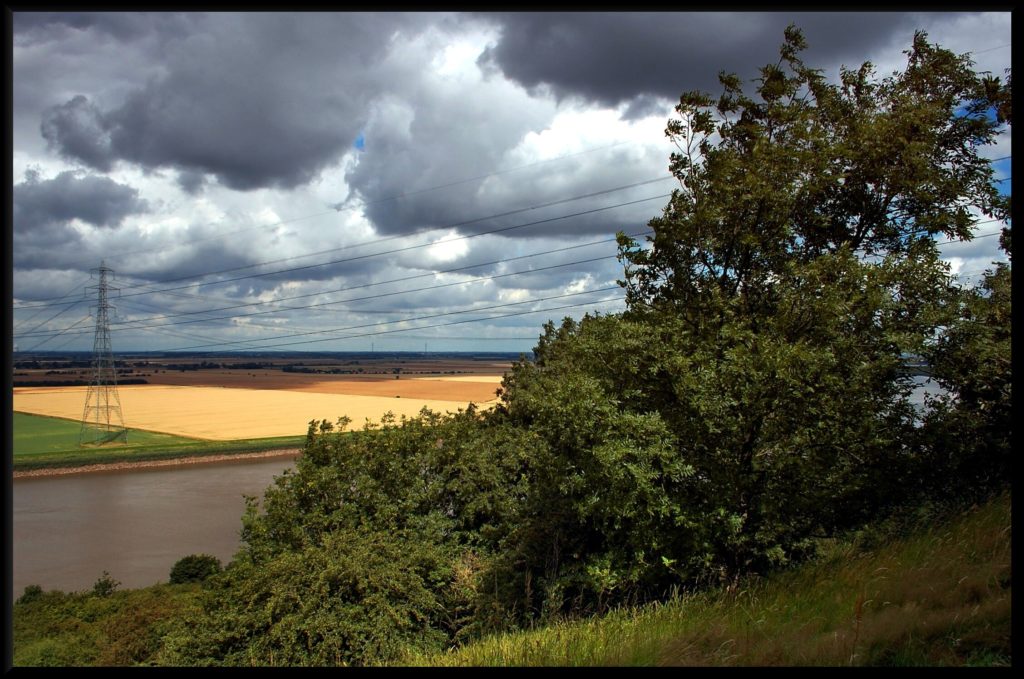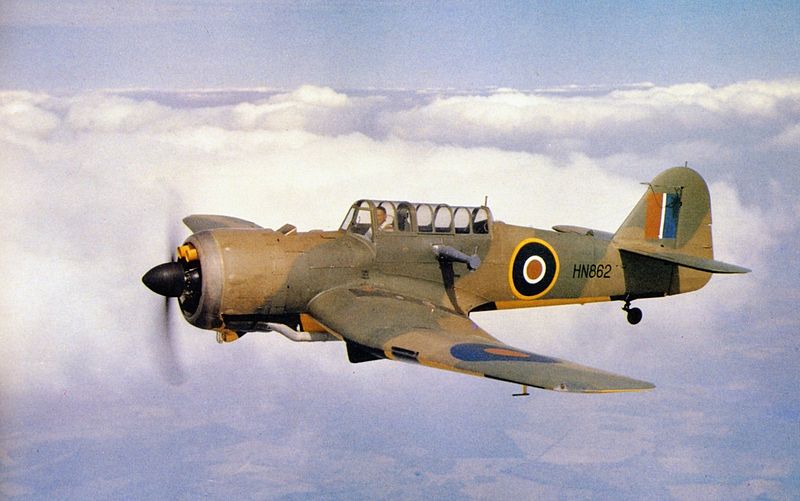Miles Martinet MS870
‹ Return to Air Crash Sites

Miles Martinet MS870, Lincolnshire
7 June 1944.
Flying Officer Gordon Smith RAFVR (82 OTU, RAF Ossington, Nottinghamshire) was flying his Miles Martinet, an aircraft designed as a target tug, as part of an exercise with a Hurricane to practice interceptions i.e. mock attacks upon each other.
30 minutes after take off the aircraft approached the power lines stretching across the River Trent at Burton-upon-Stather (which is just north of Scunthorpe) and the Hurricane broke off.
For reasons unknown, Flying Officer Smith decided to try to fly beneath the power lines, but alas had insufficient power and airspace to climb away from the steeply rising escarpment above the river and was killed instantly when the Martinet crashed into the bank.
The subsequent inquiry put the blame squarely with the pilot for unauthorised low flying.
F/O Smith was 22 years old. He was buried at Selby Cemetery in North Yorkshire.
_______________________________________________________________________
Many thanks to Al for kindly providing the Air Ministry Form 1180.
Al’s research into this crash included an interview with someone who as a child recalled seeing the body of the dead pilot hanging from the fence at the top of the slope, which is just out of sight to the right of this shot.
Other details from RAF BOMBER COMMAND LOSSES Volume 7, W R Chorley, 2002.

Photo of a Miles Martinet from Wikipedia Commons.
35 comments on “Miles Martinet MS870”
Leave a Reply Cancel reply
Image Information
-
Full Size: 2256×1496px
Aperture: f/8
Focal Length: 18mm
ISO: 200
Shutter: 1/160 sec
Camera: NIKON D40



[http://www.flickr.com/photos/solarscot]
Thanks John. Always feel slightly anxious when I see an aircraft anywhere near HT cables…. Nice to see a Hercules though!
[http://www.flickr.com/photos/32503269@N08]
Thanks Malcolm. My favourite conditions for photography, lots of cloud with occasional patches of sunlight here and there. Used an ND grad filter for the clouds.
One angry sky there mate
This came out well Ian, some very nice Lincolnshire cloudage there!
Thanks for the credit and pulling together the bits of research.
[http://www.flickr.com/photos/longsidepies]
Thanks mate
[http://www.flickr.com/photos/highy]
Thanks for showing me this place, an interesting history.
A much flatter location for you on this one. Not so much climbing needed.
Yeah, no signs of any "rock" at all in this landscape. Nicely shot picture with strong colours. The pilot took the risk and payed the ultimate price. Such a tragedy, but likely that many of us would try such a stunt at that age. Thanks for including the pic of the Martinet as I wasn’t familar with the type…hmmm I must refresh my memories by perhaps refering to a 70’s Commando comic or two..!
first off, love the shot – very summery, a wonderful breezey look there which is nice. second off, have never seen a Miles Martinet before so thankyou very much for that, i had a completely different image in my head [think very old and slow] … as for the decision to go below the lines: my guess for what it’s worth [cos to my thinking this wouldn’t have been about showing off so far from anywhere], is if he didn’t seem to the last minute and didn’t think he could get over them, only next best option is under! also, if he was towing a drogue [not sure if that is the same for intercept practise] he probably thought he wouldn’t get the aircraft and the drogue over the wires if he saw them too late. i suspect getting chased by a Hurricane would be fairly exciting and easy to lose track of ‘space’ if they were briefed on the lines etc .. and had just forgotten about them. probably looking behind him going ‘where’s that Hurri off to?’ only to turn around and see wires! poor bugger.
[http://www.flickr.com/photos/reflectionsreturn]
[http://www.flickr.com/photos/angwickham]
Thanks Mark, thanks Ang.
Yes a Martinet was not an aircraft I could immediately picture either.
As for flying beneath the power lines, the Martinet was not towing a tug, just that was what the aircraft was designed for, so not necessarilly high speed manoevres. It was at ten past three in the afternoon, there may have been cloud but the 1180 doesn’t mention that. And the same form does seem to suggest it wasn’t the first time he’d done some unauthorised low flying either. But as you say Mark, lots of young uns did it, certainly the sort of thing I might have done had I been around then. Sadly not uncommon either, I have documented a few crash sites which were a result of unauthorised low flying or aerobatics. But yeah, you may be right Ang, could have been a split second bad decision.
[http://www.flickr.com/photos/27955898@N07]
A bit of the country I’d never seen apart from Bury away to Scunthorpe.
[http://www.flickr.com/photos/maycontaintracesofnuts] if it was 1510 could it have been flying into sun / sunstrike to not see them? .. i see it was June, so i guess at 1510 the sun would still be quite high, and if he was flying in an easterly direction it would definately count it out! sorry, i do enjoy these sorts of puzzles. feel free not to respond if i’m being a pain in the arse.
ae, that whole low flying / aeros low to the ground and so on culture sure was a thing back then [and years later they still actively have to discourage it – the pix we were shown very early in training, were from the inside of a Cessna 150, after it had crashed due to mucking about buzzing a mates house. mangled and bloody controls pretty much was the image].
First of all, nice image. Second, the young pilot did nothing different than many other young men in a plane – or fighter jets or Apache helos of today. Third, your country did a smashing job of opening the Olympics! 007 and the Queen was superb!
Beautiful picture but sad story, indeed. I like the Martinet in colors! Thanks for sharing.
It is a sad story, but a lovely shot of the gorgeous landscape and clouds. :~}
Guess we’ll never know the reason for dipping under the wire…. deliberate prank or pilot error, still a sad loss.
As always, you’ve got people thinking Ian…..
great photo and info ian
Great shot of the location Ian and has been said, lovely use of the clouds (and filter). Interesting aircraft … didn’t know anything about this
Not just an interesting photo, a history story as well.
[http://www.flickr.com/photos/p47koji]
Thank you Koji. Yes the Olympics opening scenes looked good – what I saw of them. Was saying to Ben [http://www.flickr.com/photos/benoitfoisy] that I missed that night, but saw some of it on the BBC afterwards. James Bond and the Queen was fun. I like Daniel Craig cos he is two weeks older than me but looks much older. At least that’s what my mother used to say. Hope you’re well pal.
[http://www.flickr.com/photos/benoitfoisy] [http://www.flickr.com/photos/jainbow] [http://www.flickr.com/photos/cachelog] [http://www.flickr.com/photos/29730035@N04] [http://www.flickr.com/photos/55777341@N00]
Thanks folks, your thoughts are always appreciated. I use the filter just about all the time Bryan, if there’s a cloud in the sky, out comes the fiter!
[http://www.flickr.com/photos/amybigkiss] [http://www.flickr.com/photos/angwickham]
I am careful in how I present these stories. They need to be as accurate as possible of course, so what I know as fact is what gets presented. At least facts so far as it is possible to determine such…. If I only have one source for a particular detail I draw attention to that source (for instance the witness report to Al about the body on the fence). If two sources make the same point (and it is evident that one has not just copied the other) then I regard that as a fact.
I try to avoid melodrama and sentimentality, try to be dispassionate and objective but not critical or disrespectful, avoiding my own speculative thoughts, though I often quote others who speculate about the cause of these crashes!
It’s a fine balance. Hopefully people will read the story and let their own feelings dictate.
As for F/O Smith flying under the wires, was it a stunt or was it a sudden reaction to an unseen obstacle? As I say the RAF was of the opinion it it was the former. But I wasn’t there, so am happy to leave it open to those reading this to decide for themselves, which is a cop out I know!
Here’s a link to a photo of his grave, by the way.
http://www.findagrave.com/cgi-bin/fg.cgi?page=pv&GRid=380022...
Another fine shot mate.
[http://www.flickr.com/photos/maycontaintracesofnuts] a perfect approach to these kinds of things. and, not a cop out at all – rather a responsible and fair response. … me, i would like to believe it wasn’t pilot error – mainly because i like to be contrary! .. but also on the premise that so many early accidents were put down to pilot error because of a cultural mindset and/or [later on] a company or aircraft manufacturer not wanting to accept liability. i also believe that if someone had been a bit of a dick, it’s easy to say ‘he’s been a bit of a dick in the past, so we can fairly say he’s done it again’. that doesn’t wash so well with me. … however, if i were to put my thinking hat on, rather than the emotive hat, yeah i’d be with you on the ‘i wasn’t there so can’t comment’ boat. thanks always for the interesting dialogue Ian.
[http://www.flickr.com/photos/maycontaintracesofnuts] gosh, linking to the headstone heightens the sadness of this! accidents really do suck.
this is beautiful
Very sad.
[http://www.flickr.com/photos/angwickham]
Lol, no worries Ang, always happy to discuss these things! It gets us thinking and remembering.
[http://www.flickr.com/photos/tomitheos] [http://www.flickr.com/photos/hotpixuk]
Thanks chaps.
Nice work Ian , this is a little different from our usual crash site entries .
I reckon you have done a thorough job here mate . It shows the wide variety of reasons for crashing …..it wasnt all down to bad weather or damaged aircraft .
Excellent Ian…
I have looked at the crash site on Google Earth and he looks to have been flying due East at the time of impact. He would have had the sun behind him at 3.30pm, so that can rule out sun in his eyes. The altitude he was flying at was very low indeed, considering the whole area he had flown over just prior to the crash was flat farmland. Perhaps the Hurricane seeing the approaching Power lines broke away in a climb, he possibly thought this was just another practice move and as Ang said look around saw the cables too late, decided to go under, to be confronted by rapidly rising ground just over the river.. The Martinet was not particularly maneuverable ( designed to plod along with a long drogue being towed behind for air to air firing practice ) it was a little underpowered. Bristol Mercury 870 hp engine, not much for a relatively heavy aircraft. So faced with a rapid climb to avoid the rising ground, he looks like he just ran out of air space. Fighter affiliation exercises usually took place at mid to high altitude? not sure what they were doing at less than 100" above the fields. The Hurricane was possibly higher could see the looming threat and broke away climbing out at the last second, too late to warn Smith. All conjecture but one has to consider that he had done it before, the Hurricane pilot reacted faster, had a lot more powerful engine, had more time and height to pull up and away? Not knowing Smiths. flying skills, to be allocated a job flying a "Tug" and not a fighter, might have meant he lacked some of the more faster reaction times needed by fighter pilots? All conjecture and another of those unanswerable mysteries of wartime crashes. We both know Ian there were more aircrew killed in training and non combat missions than in combat.. As well as running out of sky.. he ran out of luck. RIP
[http://www.flickr.com/photos/7749921@N04]
[http://www.flickr.com/photos/29551624@N03]
Hi Richard and Cgullz I’m not sure he was flying west to east; I understood that they had been flying North to South above the Trent which would put the sun on his right side. The 1180 says that the Hurricane pilot had called off attacks and then the writing is illegible before stating that the Martinet struck the ground carrying? out unauthourised low flying.
I was told that the crash was a result of either hitting the power lines or avoiding the power lines. The pylons that carry the lines above the river here are larger than normal (to clear the river and give the line the height to get onto the escarpment on the east side) and are clearly visible for miles as is the escarpment itself), which gives credence to the idea that he didn’t see them until too late.
F/O Smith had logged 362 hours with 134 of them on type so he would have been well versed with the performance of the Martinet. I’ve often stood as this site and wondered if he tried to go below the lines because he knew he couldn’t climb over them.
As you say all conjecture, we’ll never know for sure. Great that Ian’s post has opened this debate and made folks aware of F/O Smiths sacrifice.
Lovely photograph Ian and another sad story in aviation history.
[http://www.flickr.com/photos/highy] thanks Al .. bugger that illegible writing huh! i enjoy this nutting things out and even though speculation it does get us all talking and thinking different angles which is great. thanks for the info you’ve supplied.
a personal story: i drove the same stretch of road every weekend for 3 years, knew all the danger spots, all the congestion spots, knew my car well, was trained in speed / distance judgement – decision making – risk assessment – ‘human factors’ etc etc, and i still managed to park my car up the arse of another. many reasons as to why and how it happened [the very crux of it being i took my eyes off the road for 2 seconds – blind spot vulnerable] .. but after all the analysis, just an accident. a frustrating and simple accident. so easily done and really taught me the true meaning of the word ‘accident’ and just how simple it is to cock something up, royally.
ang
[http://www.flickr.com/photos/bill_fawcett] Cheers Bill!
[http://www.flickr.com/photos/angwickham] [http://www.flickr.com/photos/highy] [http://www.flickr.com/photos/richardtierney]
Thanks all for contributing so much to this analysis of the events. My view on what happened – whether it was a last minute decision to duck under the wires to avoid them or whether F/O Smith intended to fly beneath them, was his decision may have been influenced by the deceptive height difference between the top of the bank and the ground below. It looks much higher in the photo above, because of the plain stretching out to the west exaggerates the difference in the height of the rising bank. But it is less than 200 feet from top to bottom.
No room for error but as Al says he would have been well familiar with the performance of the Martinet. I figured he was flying from north or north west to south or south east, otherwise he could have flown along the river (unless he caught the wires).
Just to throw in something else (and I am not at all certain how valid this view is!) but I have read that there is a natural tendency in human beings, especially right handed ones, to veer to the left in an emergency. That’s why we drive on the left, to veeer away from oncoming traffic takes us out of danger, though we might then run over a pedestrian….
Some theories around it being hard wired because we would defend ourselves with a sword in our right hand sound a bit far fetched – how many of our ancestors routinely carried a sword? But still there may be something in it.
So if F/O Smith went underneath the wires (for whatever reason) and realised he was going to end up in the River Trent, veering left into the rising bank may have been an instinctive thing for him to do, whereas a cimb to the right could have seen him clear….
Unless as Al suggests he clipped the wires in which case he was doomed anyway.
[http://www.flickr.com/photos/maycontaintracesofnuts]
"I figured he was flying from north or north west to south or south east, otherwise he could have flown along the river (unless he caught the wires). " …
you may have it in a nutshell Ian & Al, as 200′ below the wires is still sufficient to fit an aircraft of that size .. and yeah, so why didn’t he just follow the river? .. hitting the wires / loss of control could explain parking it in the bank. i guess the report may indirectly reflect what happened in what they didn’t report [that is, they didn’t discuss aircraft failure such as due wire damage] .. but then that could simply relfect the culture of the day; the pilot cocked up = pilot error.
as for the left hand / right hand thing – i’m left handed [though not ridiculously so] so have a natural tendency to go that way, there was also an unusally high incidence of left handedness in the pilot’s crew room … funny thing is that air to air ’emergency avoidance manoeuvres’ dictate a turn to the right!
Sad but also fascinating too Ian as all the conversations imply.
Just to throw in another observation, these wires are affected by temperature and being June, were they lower than usual in the warmer air? F/O Smith may have seen them before and thought he had a chance to go under if indeed it was pre-meditated but found to his cost on the day that there was less room than he thought as the pylons themselves would be more visible but the wires less so especially against the escarpment background? Either way a sad end to a young life.
[http://www.flickr.com/photos/29288836@N00] " these wires are affected by temperature and being June, were they lower than usual in the warmer air: – what a fantastic insight!
Super Colours.
[http://www.flickr.com/photos/ianlayzellphotographs] [http://www.flickr.com/photos/29288836@N00] [http://www.flickr.com/photos/angwickham] Thanks guys, the story of F/O Smith’s last moments has really caught people’s attention.
[http://www.flickr.com/photos/highy]
Al that photo deserves to be viewed large but I can’t grab the HTML from your photo in a bigger size, could you change it for one in a larger size please?
A view looking down onto the Trent valley from the hillside, hopefully it shows the clearance between wires and the river fairly well; it’s about 130ft down to the river here:
[http://www.flickr.com/photos/highy/7846411172/sizes/z/]
I can’t post it any lager Ian, which ever size picture link I use; you get this!